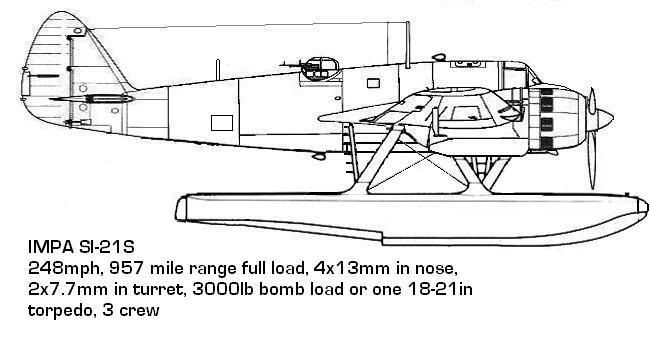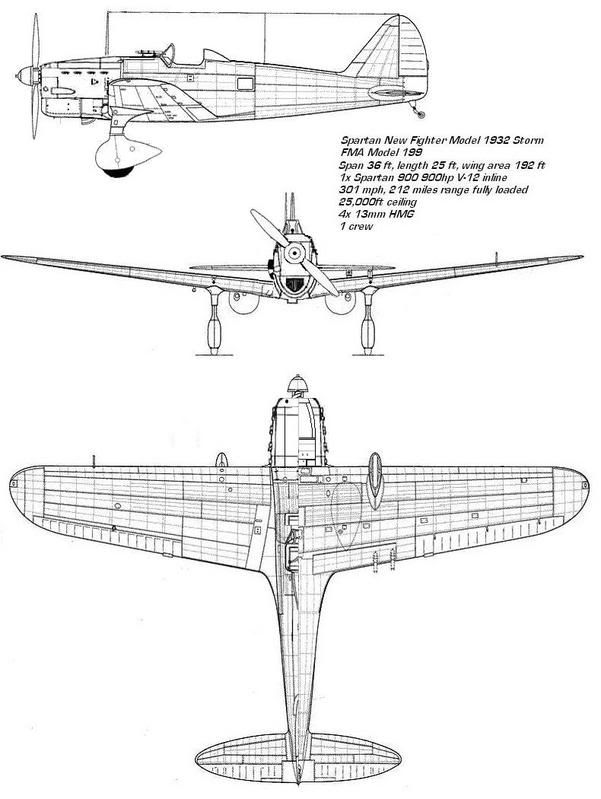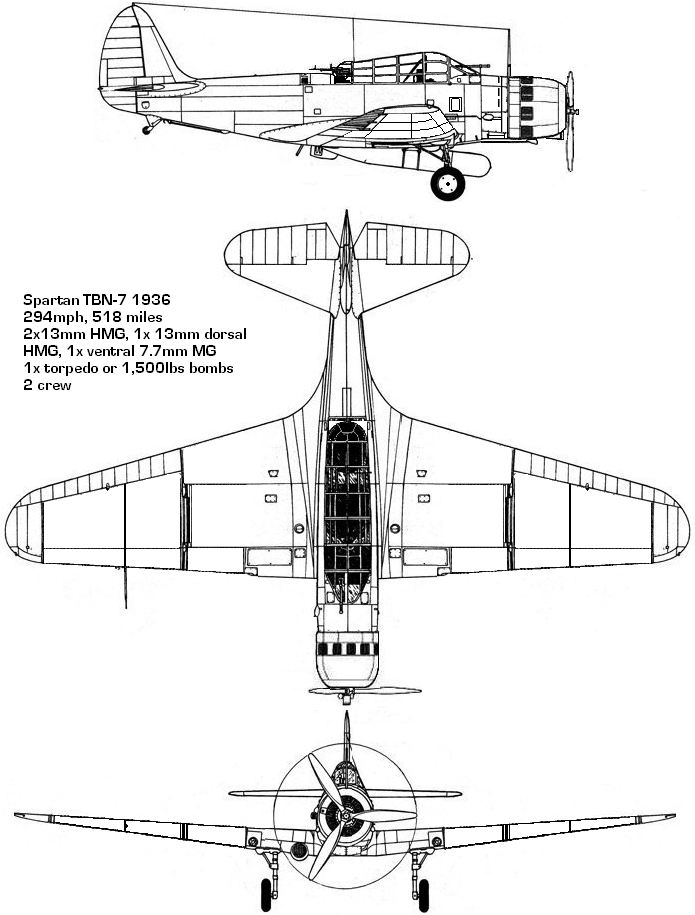IMPA M.B.1 (Spartan Vanquish)

This was the first variant of the Spartan Vanquish to be built in Argentina from 1934 and 148 were built.
Dimensions: span 20.42m; length 12.19; height 3.5m; wing area 600sq ft; wing loading 24.66 lb/sq ft; power loading 0.297kg/hp 0.13 lb/hp
Structure: all-metal monocoque fuselage in three sections with Z section fames and L section stringers with light alloy covering, light alloy used for cantilever tail construction and tailplane covering. Cantilever metal wing with two steel spars, all-metal split flaps and aluminium framed ailerons with fabric covering. Rudder and elevators aluminium framed with fabric covering. Retractable hydraulically raised main undercarriage with two oleo-pneumatic legs with twin pneumatic brakes and a non-retractable castoring tail wheel
Weights: empty 9,434lbs, maximum take-off 14,800lbs
Powerplant: two 1000hp Spartan 1000 radial engines un-supercharged
Performance: max speed 256mph; service ceiling 23,200ft; rate of climb 1,481ft per minute at 1,500ft; range 1970 miles with 1,000lbs bomb load
Capacity: pilot in enclosed cockpit with navigator/bomb aimer beside and slightly lower with a nose bomb-aiming position, radio operator/gunner in rear fuselage
Armament: one dorsal turret with two 7.92mm FMG/M32 MG (drum feed), two 13mm Browning HMG in wingroots, bombload 2000lbs in one lower fuselage bomb bay
Equipment: full controls and navigation equipment including receiver/transmitter, HF/DF set and Sperry autopilot, two cameras can be fitted in cabin floor, one flare chute, one rescue dinghy, simple mechanical bombsight
IMPA SI-21A (Sp-21A Vanquish II)

Further development with better engines and an improved bomb aimer's postiton led to 240 of the Vanquish II being built between 1935 and 1937.
Dimensions: span 20.42m; length 14.63; height 3.84m; wing area 600sq ft; wing loading 31.33 lb/sq ft; power loading 0.234kg/hp 0.10 lb/hp
Structure: all-metal monocoque fuselage in three sections with Z section fames and L section stringers with light alloy covering, light alloy used for tail construction and cantilever tailplane covering. Cantilever all-metal wing with two steel spars, all-metal split flaps and aluminium framed ailerons with fabric covering. Rudder and elevators aluminium framed with fabric covering. Retractable hydraulically raised main undercarriage with two oleo-pneumatic legs with twin pneumatic brakes and a non-retractable castoring tail wheel
Weights: empty 10,825lbs, maximum take-off 18,800lbs
Powerplant: two 1000hp Spartan 1000 supercharged radial engines
Performance: max speed 262mph; service ceiling 26,500ft; rate of climb 1,078ft per minute at 1,500ft; range 1152 miles with 4,000lbs bomb load
Capacity: pilot in enclosed cockpit, navigator/bomb aimer in nose with a glazed bomb-aiming position, radio operator in rear fuselage compartment with two windows ahead of gunner in a hydraulic-powered dorsal turret
Armament: one dorsal turret with two 7.92mm FMG/M32 MG (drum feed), one 7.92mm FMG/M32 MG (drum feed) on swivel mount in nose, two 7.92mm FMG/M32Ar MG (belt feed) in wingroots, bombload 4000lbs in one lower fuselage bomb bay or one semi-recessed 18in torpedo
Equipment: full controls and navigation equipment including receiver/transmitter, HF/DF set, naval co-operation beacon and Sperry autopilot, two cameras can be fitted in cabin floor, one flare chute, two rescue dinghies and mechanical bombsight
IMPA SI-21B (Vanquish III)
IMPA's own engineers developed this final variant to replace the worn out bombers which had seen war service and to further increase the performance. 164 have been built or ordered to date.
Dimensions: span 20.42m; length 14.63; height 3.84m; wing area 600sq ft; wing loading 32 lb/sq ft; power loading 0.13 lb/hp
Structure: all-metal monocoque fuselage in three sections with Z section fames and L section stringers with light alloy covering, light alloy used for tail construction and cantilever tailplane covering. Behind the pilot is a 5mm thick armoured bulkhead. Cantilever all-metal wing with two steel spars, all-metal split flaps and aluminium framed ailerons with fabric covering. Self-sealing fuel tanks carried in the wings. Rudder and elevators aluminium framed with fabric covering. Retractable hydraulically raised main undercarriage with two oleo-pneumatic legs with twin pneumatic brakes and a retractable castoring tail wheel
Weights: empty 11,120lbs, maximum take-off 19,000lbs
Powerplant: two 1200hp Ripon R-1200-010A supercharged radial engines
Performance: max speed 291mph at 15,000 feet; cruising speed 201mph at 15,000 feet; service ceiling 29,500ft; rate of climb 1,562ft per minute at 1,500ft; range 1060 miles with 4,000lbs bomb load
Capacity: pilot in enclosed cockpit, navigator/bomb aimer in nose with a glazed bomb-aiming position, radio operator in rear fuselage compartment with two windows ahead of gunner in a hydraulic-powered dorsal turret
Armament: one dorsal turret with two 13mm Browning MG (belt feed), one 13mm Browning MG (belt feed) on swivel mount in nose; bombload 4000lbs in one lower fuselage bomb bay with hydraulic doors
Equipment: full controls and navigation equipment including receiver/transmitter, HF/DF set, naval co-operation beacon and Sperry autopilot, two cameras can be fitted in cabin floor, one flare chute, two rescue dinghies and mechanical bombsight
IMPA SI-21T (Sp-21M)

The Sp-21M was an export variant intended for Mexico but the FAA was so impressed that it ordered several during the war.
Dimensions: span 20.42m; length 12.19; height 3.84m; wing area 600sq ft; wing loading 31.33 lb/sq ft; power loading 0.234kg/hp 0.10 lb/hp
Structure: all-metal monocoque fuselage in four sections with Z section fames and L section stringers with light alloy covering, light alloy used for tail construction and cantilever tailplane covering. Cantilever all-metal wing with two steel spars, all-metal split flaps and aluminium framed ailerons with fabric covering. Rudder and elevators aluminium framed with fabric covering. Retractable hydraulically raised main undercarriage with two oleo-pneumatic legs with twin pneumatic brakes and a non-retractable castoring tail wheel
Weights: empty 11,670lbs, maximum take-off 18,800lbs Powerplant: two 1000hp Spartan 1000 supercharged radial engines
Performance: max speed 267mph; service ceiling 26,500ft; rate of climb 1,094ft per minute at 1,500ft; range 1200 miles with 3,000lbs bomb load
Capacity: pilot in enclosed cockpit with bullet-proof windscreen, navigator in rear fuselage cabin with one window and one access door ahead of radio operator/gunner in a hydraulic-powered dorsal turret
Armament: one dorsal turret with two 7.92mm FMG/M32 MG (drum feed), four fixed 13mm Browning HMG in the lower nose under the cockpit, bombload 3000lbs in one lower fuselage bomb bay or one semi-recessed 18-21in torpedo
Equipment: full controls and navigation equipment including receiver/transmitter, HF/DF set, naval co-operation beacon and Sperry autopilot, two cameras can be fitted in cabin floor, one flare chute, two rescue dinghies and mechanical bombsight
IMPA SI-21S

A floatplane equipped Sp-21 variant for the Commando de Aviacion Naval for the reconnaissance role with a secondary attack role. The third pre-production aircraft was fitted with floats at the insistence of the Commando de Aviacion Naval Argentina to fulfill an urgent need for seaplanes. Around 20 were converted on the production line from mid 1935.
Dimensions: span 20.42m; length 12.19; height 3.84m; wing area 600sq ft; wing loading 31.33 lb/sq ft; power loading 0.234kg/hp 0.10 lb/hp
Structure: all-metal monocoque fuselage in four sections with Z section fames and L section stringers with light alloy covering, light alloy used for tail construction and cantilever tailplane covering. Cantilever all-metal wing with two steel spars, all-metal split flaps and aluminium framed ailerons with fabric covering. Rudder and elevators aluminium framed with fabric covering. Two amphibious watertight floats fixed underwing with optional beaching wheels.
Weights: empty 11,670lbs, maximum take-off 18,800lbs Powerplant: two 1000hp Spartan 1000 supercharged radial engines
Performance: max speed 248mph; service ceiling 25,500ft; rate of climb 1,025ft per minute at 1,500ft; range 957 miles with 3,000lbs bomb load
Capacity: pilot in enclosed cockpit, navigator in rear fuselage cabin with one window and one access door ahead of radio operator/gunner in a hydraulic-powered dorsal turret
Armament: one dorsal turret with two 7.92mm FMG/M32 MG (drum feed), four fixed 13mm Browning HMG in the lower nose under the cockpit, bombload 3000lbs in one lower fuselage bomb bay or one semi-recessed 18-21in torpedo
Equipment: full controls and navigation equipment including receiver/transmitter, HF/DF set, naval co-operation beacon, Sperry autopilot, reflector gun sight with torpedo aiming bar, two cameras fitted in navigator's cabin floor, three flare chutes and two rescue dinghies.






